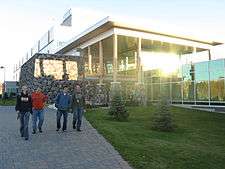Northern Ontario School of Medicine
| Northern Ontario School of Medicine | |
|---|---|
| Established | 2005 |
| Type | Medical school |
| Location | Sudbury and Thunder Bay, Ontario, Canada |
| Dean | Roger Strasser |
| Academic staff | 350 |
| Students | 224 |
| Website |
www |
 | |
The Northern Ontario School of Medicine (École de médecine du Nord de l'Ontario) is a medical school in the Canadian province of Ontario, created through a partnership between Laurentian University in Sudbury and Lakehead University in Thunder Bay. Mandated both to educate doctors and to contribute to care in Northern Ontario's urban, rural and remote communities, the Northern Ontario School of Medicine has campuses in both Sudbury and Thunder Bay.[1]
The school is known for its small class size, its distributed model of education, heavy emphasis on enabling technologies, problem-based and self-directed learning, and early exposure to clinical skills. The school describes its campus as "Northern Ontario". This is evidenced by the close relationship between the school and various communities and First Nations throughout the region. All students complete a month-long placement in an Aboriginal or Métis community in May of their first year. In second year, they travel to smaller communities for two, month-long placements (one in the fall and the other in the winter). The third year is clerkship and is spent living in one of the medium sized communities for the entire year. The fourth year of studies is completed in Sudbury or Thunder Bay.
History
Before the creation of NOSM, Northern Ontario had for several years been designated as "underserviced", meaning that the region's ratio of medical professionals to the general population was not meeting the standards set by the Ministry of Health. As a result, a multifaceted plan was adopted by the province, including the creation of NOSM and the adoption of special recruitment strategies. A study of medical services in Ontario, released in August 2005, found that for the first time in many years, the region's level of medical services had improved over the previous year.
Construction on both campuses began in mid-2004, and the buildings were completed in August 2005. NOSM accepted its charter class of 56 students in September of that same year and the school was officially opened by Premier Dalton McGuinty on 13 September 2005. The school received full accreditation from the Committee on Accreditation of Canadian Medical Schools (CACMS) and the Liaison Committee on Medical Education (LCME) in February 2009.
A fictionalized version of the school, renamed Boreal Medical School, is the setting of the Canadian television drama series Hard Rock Medical, which debuted on TVOntario and APTN in July 2013.[2]
Admissions

The Northern Ontario School of Medicine is one of only two medical schools in Canada outside of Quebec (along with University of Ottawa) that does not require an MCAT score to be considered for admission. Furthermore, the only academic prerequisite is a university undergraduate degree with a minimum GPA of 3.0 out of 4.0 (the mean GPA of the 2013/2014 entering class was 3.83[3]). To help further its social accountability mandate, NOSM does take into account where candidates are from and whether they have studied or worked in Northern Ontario or other rural or remote places. For each entering class since the schools inception in 2005, approximately 90-95% were from Northern Ontario.[3] Each year, approximately 2000 applicants compete for the 64 spots in each class (36 at the Sudbury campus and 28 at the Thunder Bay campus). Applicants request their preferred campus at the time of their interview.
Hospitals
Fully affiliated teaching hospitals:
- Health Sciences North – Sudbury
- Thunder Bay Regional Health Sciences Centre – Thunder Bay
Larger community teaching hospitals:
- South Muskoka Memorial Hospital – Bracebridge
- LaVerendrye Hospital – Fort Frances
- Huntsville District Memorial Hospital – Huntsville
- Lake of the Woods District Hospital – Kenora
- Temiskaming Hospital – New Liskeard
- North Bay General Hospital – North Bay
- West Parry Sound Health Centre – Parry Sound
- Sault Area Hospital – Sault Ste. Marie
- Sioux Lookout Meno Ya Win Health Centre – Sioux Lookout
- Timmins and District Hospital – Timmins
Health Sciences Library
The Northern Ontario School of Medicine also operates the Health Sciences Library (HSL), formerly known as the Northern Ontario Virtual Library (NOVL) to northern health-care professionals, and the Health Information Resource Centre (HIRC) to faculty, students and residents. The HSL aims to meet the traditional and expanding information needs of NOSM's learners and faculty, as well as registered health professionals throughout the region of Northern Ontario. It sponsors in-person and technologically mediated instruction on the latest health sciences resources and information technology, among other topics. The explicit aim is to further the practice of evidence-based medicine in the north, with special focus on the physicians, residents, nurses, occupational therapists, physiotherapists, and other health care professionals in northern and/or rural communities.
See also
References
- ↑ "Northern Ontario School of Medicine delivers more doctors to the north". www.cbc.ca. CBC News, Thunder Bay. August 26, 2015. Retrieved June 3, 2016.
- ↑ "Canadian Drama 'Hard Rock Medical' Gets Full-Season Order". The Hollywood Reporter, December 9, 2011.
- 1 2 http://www.nosm.ca/classprofiles/
External links
- Northern Ontario School of Medicine
- Northern Ontario School of Medicine Faculty & Staff Association & OPSEU Local 677
- Northern Ontario School of Medicine Student Society
- NOSM's Health Sciences Library
| Wikimedia Commons has media related to Northern Ontario School of Medicine. |
Coordinates: 46°27′50″N 80°57′56″W / 46.46388°N 80.96546°W